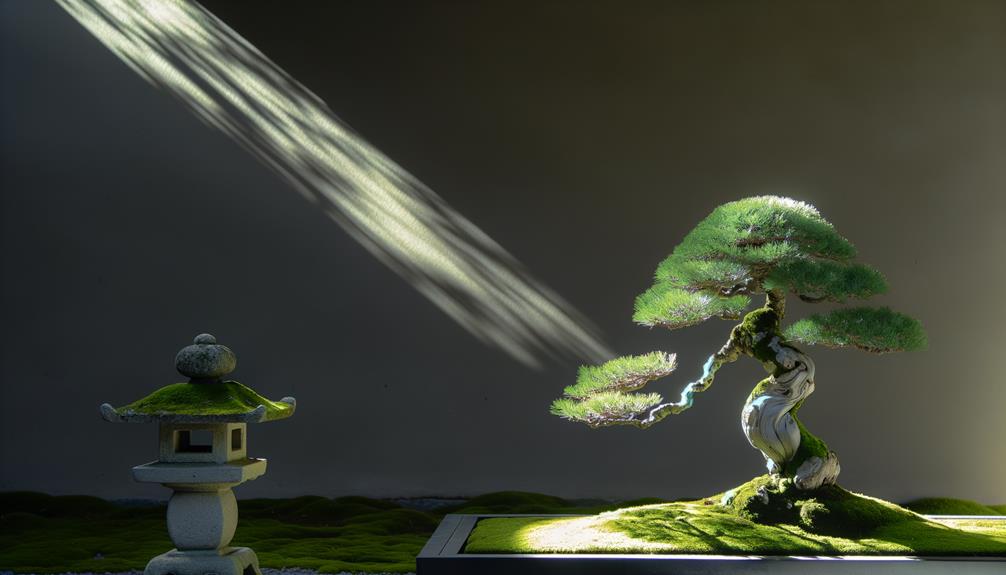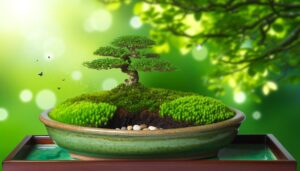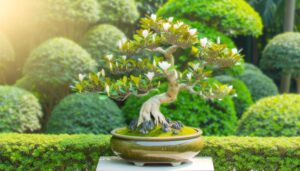Bonsai Tree Advantages and Disadvantages You Should Know
Cultivating bonsai trees provides numerous advantages including aesthetic appeal, enhancing balance and harmony, and offering therapeutic stress relief by reducing cortisol and stimulating serotonin. Their small size maximizes space efficiency.
Bonsai culture also fosters creativity through intricate pruning and wiring techniques. Conversely, it demands substantial time commitment for detailed daily care and long-term maintenance.
Specialized horticultural skills are necessary for best plant health, and the costs for initial investment, ongoing supplies, and training can be considerable. Mastering these facets delivers immense satisfaction and impressive results for dedicated enthusiasts seeking further details about this sophisticated art form.

Key Takeaways
- Advantages: Bonsai trees offer a unique and rewarding hobby experience, combining horticulture with artistic expression.
- Advantages: They enhance patience and mindfulness, promoting mental well-being and cognitive relaxation.
- Advantages: Their diminutive size and controlled growth make them ideal for small apartments or offices.
- Disadvantages: Bonsai cultivation requires significant time commitment for daily care, pruning, and maintenance.
- Disadvantages: Initial and ongoing costs can be substantial, including soil, fertilizers, and specialized training.
Aesthetic Appeal

The aesthetic charm of bonsai trees lies in their detailed design, which embodies principles of balance, harmony, and proportion, often creating a living work of art that reflects both natural beauty and human craftsmanship.
This intricate art form involves precise pruning, wiring, and potting techniques to control growth patterns and shape. The resulting miniature trees mirror the grandeur of full-sized counterparts, encapsulating complex ecological systems within confined spaces.
The horticultural proficiency required for bonsai cultivation emphasizes understanding plant physiology, growth cycles, and environmental responses. Each specimen becomes a testament to the symbiotic relationship between nature and human intervention, where aesthetic considerations are meticulously balanced with botanical health, thereby producing a visually captivating and scientifically fascinating botanical phenomenon.
Stress Relief
Beyond their aesthetic appeal, bonsai trees also offer significant benefits in stress relief. They leverage their intricate care routines and serene presence to promote mental well-being and cognitive relaxation.
Engaging in the meticulous process of pruning, wiring, and repotting can activate the parasympathetic nervous system. This helps reduce cortisol levels and induces a state of calm. The repetitive, mindful actions involved in bonsai care are analogous to practices such as meditation, which have been scientifically proven to enhance psychological resilience.
Moreover, the visual tranquility provided by bonsai trees can stimulate the release of serotonin. This contributes to a sense of happiness and emotional stability. These combined effects highlight the therapeutic potential of bonsai cultivation, making it a valuable practice for stress management.
Space Efficiency

Due to their diminutive size and adaptable growth patterns, bonsai trees are exceptionally suited for environments with limited space, such as small apartments or urban offices. The constrained root system and controlled canopy size inherent in bonsai cultivation allow these miniature trees to thrive in compact containers.
This characteristic enables efficient utilization of vertical and horizontal space, optimizing spatial dynamics in confined settings. Moreover, the disciplined pruning and wiring techniques employed in bonsai maintenance facilitate meticulous growth management, ensuring the plant remains proportionate to its container.
This space efficiency can contribute to an enhanced aesthetic appeal in otherwise cramped areas, providing a sense of natural tranquility without compromising functional living or working space.
Creative Expression
In addition to optimizing spatial dynamics, bonsai cultivation offers an unparalleled avenue for creative expression through meticulous techniques such as pruning, wiring, and shaping.
Pruning is integral for controlling the tree's growth patterns, ensuring the desired aesthetic form. Wiring involves the application of aluminum or copper wires to guide branches into specific configurations, fostering intricate designs. Shaping, encompassing both selective trimming and strategic bending, allows for the realization of complex artistic visions.
This confluence of horticultural skill and artistic creativity facilitates a dynamic interaction between the cultivator and the tree, enabling the manifestation of individualized, living sculptures. Consequently, bonsai artistry serves as a conduit for personal expression, merging botanical science with aesthetic innovation.
Time Commitment

The cultivation of bonsai trees requires substantial time investment, encompassing both daily care requirements and long-term maintenance.
Daily tasks such as precise watering, pruning, and monitoring for pests demand careful attention to guarantee the tree's health and aesthetic appeal.
Additionally, the long-term commitment involves periodic repotting, root trimming, and seasonal adjustments, which are essential for the sustained strength and growth of the bonsai.
Daily Care Requirements
Caring for a bonsai tree requires a detailed and consistent time commitment. These miniature trees need regular pruning, watering, and monitoring to maintain their health and aesthetic form.
Daily attention is essential for managing the microenvironment. This ensures ideal humidity, light exposure, and soil moisture levels. Pruning must be carried out with accuracy to control growth patterns and promote desirable morphological characteristics.
Watering schedules must be strictly followed. Bonsai trees are highly vulnerable to both insufficient and excessive watering, affecting root health.
Additionally, attentive observation for pests and diseases is vital, requiring immediate intervention to prevent infestations.
Long-Term Maintenance
Maintaining a bonsai tree over the long haul requires sustained and thorough attention to its physiological and morphological requirements, building upon the foundational daily care routine. This involves a detailed understanding of the tree's growth patterns, nutrient needs, and environmental conditions.
The primary aspects of long-term maintenance include:
- Pruning: Regular trimming to control growth and shape the tree.
- Repotting: Periodic soil replacement and root pruning to prevent root-bound conditions.
- Pest Management: Ongoing vigilance for pests and diseases, employing biological and chemical controls as needed.
- Seasonal Care: Adjusting water, light, and temperature needs according to seasonal changes to promote peak health.
Such dedication guarantees the bonsai's longevity and aesthetic appeal, requiring both time and expertise.
Skill Requirements
Cultivating a bonsai tree requires expertise in horticultural techniques. This includes pruning, wiring, and root trimming, which call for specific tools like bonsai shears, concave cutters, and wire pliers.
Additionally, the intricate nature of bonsai maintenance demands a significant time investment. This time is needed to monitor growth, address pests, and maintain peak health.
Consequently, the skill requirements encompass both a foundational understanding of botanical principles and a sustained commitment to meticulous care.
Basic Tools Needed
A detailed understanding of bonsai cultivation necessitates the use of specialized tools designed to facilitate precision and promote the tree's aesthetic and structural integrity. The following essential tools are critical for maintaining the health and appearance of bonsai trees:
- Concave Cutters: These are used for pruning branches close to the trunk, resulting in minimal scarring and promoting faster healing.
- Root Rake: This tool helps in untangling and combing out roots during repotting, ensuring optimal root spread and nutrient absorption.
- Bonsai Scissors: Precision scissors are crucial for trimming leaves and small branches, allowing for meticulous shaping.
- Wire and Wire Cutters: Aluminum or copper wires are employed to guide branch positioning, while wire cutters guarantee clean cuts without damaging the tree.
Proper utilization of these tools underpins successful bonsai cultivation.
Time Commitment
Successful bonsai cultivation demands significant time investment and a high level of skill to guarantee meticulous care and precise shaping. The process involves intricate pruning, precise wiring, and attentive watering schedules, each contributing to the plant's aesthetic and health. Mastery of these techniques requires continuous learning and practice, often spanning years.
Additionally, understanding the specific physiological needs of different bonsai species—such as light requirements, soil composition, and humidity levels—is essential. Seasonal tasks, including repotting and pest management, further add to the time commitment. This dedication ensures the bonsai's longevity and beauty, reflecting the grower's expertise.
Consequently, the time-intensive nature of bonsai cultivation can be a significant disadvantage for individuals unable to allocate consistent attention.
Cost Considerations

When evaluating the cost considerations of bonsai tree cultivation, it is essential to account for initial investment, ongoing maintenance expenses, and potential unforeseen costs.
A detailed financial analysis reveals several critical expenditure categories:
- Initial Investment: Purchasing a high-quality bonsai tree and essential tools can range from $50 to several thousand dollars, depending on species and age.
- Ongoing Maintenance: This includes costs for specialized soil, fertilizers, and pesticides, which can accumulate significantly over time.
- Training and Education: Engaging in workshops, purchasing literature, or seeking expert consultation can incur additional expenses.
- Unforeseen Costs: Unexpected issues such as pest infestations or diseases may require immediate and costly interventions.
Understanding these factors is pivotal for prospective bonsai enthusiasts to make informed financial decisions.
Maintenance Needs
Proper maintenance of bonsai trees frequently demands meticulous attention to watering, pruning, and environmental control to guarantee their peak health and aesthetic appeal.
Consistent irrigation is essential, as bonsai trees require precise moisture levels to avoid desiccation or root rot.
Pruning, both structural and maintenance, is necessary for shaping and promoting healthy growth patterns.
Environmental control, involving light exposure, humidity, and temperature regulation, must be finely tuned to replicate the bonsai's native habitat.
Utilization of appropriate soil mixtures ensures adequate drainage and nutrient availability.
Additionally, pest management is crucial to prevent infestations that could jeopardize the tree's vitality.
Collectively, these maintenance practices necessitate a thorough understanding of horticultural principles and a commitment to ongoing care.
Conclusion
To sum up, cultivating bonsai trees offers significant benefits such as aesthetic pleasure, stress reduction, and efficient space utilization. Simultaneously, it presents challenges including substantial time investment, specialized skill acquisition, financial outlay, and ongoing maintenance requirements.
Remarkably, a study conducted by the National Gardening Association reveals that 70% of bonsai enthusiasts report a marked reduction in stress levels, underscoring the profound therapeutic impact of this horticultural practice.
Consequently, the advantages and disadvantages must be carefully weighed by potential cultivators.






